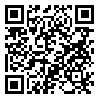Mon, May 6, 2024
[Archive]
Volume 15, Issue 2 (3-2023)
2023, 15(2): 1-11 |
Back to browse issues page
Download citation:
BibTeX | RIS | EndNote | Medlars | ProCite | Reference Manager | RefWorks
Send citation to:



BibTeX | RIS | EndNote | Medlars | ProCite | Reference Manager | RefWorks
Send citation to:
Falsafi S, Khodadadi H. Transmitted Data Security in Non-Orthogonal Multiple Access Networks with Directional Modulation Based on User Location. International Journal of Information and Communication Technology Research 2023; 15 (2) : 1
URL: http://ijict.itrc.ac.ir/article-1-542-en.html
URL: http://ijict.itrc.ac.ir/article-1-542-en.html
1- Faculty of Electrical and Computer Engineering Imam Hossain Comprehensive University Tehran, Iran
2- Faculty of Electrical and Computer Engineering Imam Hossain Comprehensive University Tehran, Iran , fajr@ihu.ac.ir
2- Faculty of Electrical and Computer Engineering Imam Hossain Comprehensive University Tehran, Iran , fajr@ihu.ac.ir
Abstract: (786 Views)
In Non-orthogonal multiple access, a user with a weaker channel gain is assigned more power than a user with a stronger channel. This type of power allocation allows the strong user (SU) to apply the successive interference cancellation (SIC) method that first detects the symbols of the weak user (WU) before detecting its data. The SIC method makes the WU data vulnerable to eavesdropping at the SU and so increases the detection complexity. This paper studies the physical layer security of the data against eavesdropping. The proposed scheme uses directional modulation that distorts the symbols transmitted in an undesired direction therefore the external eavesdroppers receive different symbols. It becomes complicated for an external eavesdropper to track and detect the signal of legitimate users. This scheme eliminates the WU data on the location of the SU so the strong user does not need the SIC. We analyze the impacts of various factors on security, such as the number of antennas and the secrecy rate.
Article number: 1
Type of Study: Research |
Subject:
Communication Technology
Send email to the article author
| Rights and permissions | |
 | This work is licensed under a Creative Commons Attribution-NonCommercial 4.0 International License. |




